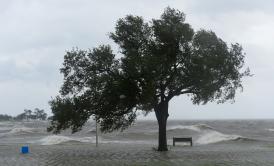Hurricane Isaac is hovering just along the Gulf Coast on Wednesday morning, pretty much drenching anyone and everything in Louisiana, Mississippi and neighboring states. The storm is expected to stick around for the next several hours, so it’s probably too early to tell exactly how much damage it is going to do.
One troubling piece of news, however, involves Louisiana’s levees and other flood-protection systems along the coast. In Plaquemines Parish, roughly 95 miles outside New Orleans, water “overtopped” a local levee early Wednesday, causing extensive flooding in the area, according to the National Weather Service, and reportedly damaging multiple homes in the area.
The specific levee in question, however, is not one that the U.S. government had to rebuild in the wake of Katrina. The New York Times with more.
The levee is not one of the large, federally maintained earthworks lining the Mississippi River, but a locally maintained levee some 8 feet high, and lower than the 12-foot surge that hit it, according to officials from the Army Corps of Engineers. The water is threatening people living along the east bank of the parish, near the mouth of the Mississippi River, who did not comply with the mandatory evacuation.
CNN is reporting that an untold number of people are believed to be trapped in their homes in Plaquemines Parish, and that a group of boaters is on the way out to rescue them this morning.
Sen. David Vitter, a Louisiana Republican, told CNN this morning that according to the Army Corps of Engineers briefing he received, the potential flooding is currently the biggest concern in his state, and not the major levees holding up.
Here’s the latest from the National Weather Service: “Isaac has been drifting slowly westward along the coast of Louisiana south of New Orleans, but it has been nearly stationary at times. This is allowing copious rainfall and prolonged storm surge into southern Louisiana and Mississippi. Significant flooding is expected in this area.”
